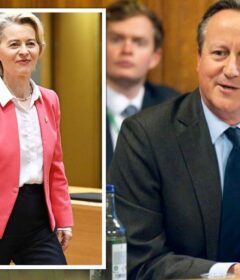Rust Belt, Sun Belt or Both? Democrats Seek the Best Route to the White House
DES MOINES — At the very first event of her first full day in Iowa as a presidential candidate, Senator Kamala Harris was greeted by a Democratic voter who delivered a pointed recommendation about the best path to the White House.
The voter, Rahul Parsa, who teaches at Iowa State University’s business school, said he told Ms. Harris at a gathering of Asian and Latino activists that she needs to think of the Democratic Party in the Midwest like a struggling retail business — and that she should seek out not just the regular customers, but those who are not loyal supporters as well.
“Kamala needs to find out why the people voted for Trump, what are their issues?” said Mr. Parsa, adding that he had one overarching demand for the burgeoning field of would-be nominees: “You need to bring some states in the Midwest.”
As the Democratic race takes flight, with one or more candidates entering the race almost every week, Mr. Parsa’s viewpoint represents one side of a long-simmering debate within the party: Should Democrats redouble their efforts to win back the industrial heartland that effectively delivered the presidency to Donald J. Trump, or turn their attention to more demographically promising Sun Belt states like Georgia and Arizona?
With polls indicating that electoral viability is as important to voters as any policy issue, a handful of the party’s prospects are already holding up their Midwestern credentials to make the case that they are the ones who can turn Big 10 country — Pennsylvania, Michigan, Wisconsin — blue again.
[Make sense of the people, issues and ideas shaping American politics with our newsletter.]
Senator Amy Klobuchar of Minnesota went immediately to next-door Wisconsin after declaring her candidacy earlier this month, making a hard-to-miss point about her eagerness to compete in a state Hillary Clinton never visited in the 2016 general election. Senator Sherrod Brown of Ohio, who has not officially entered the race, used his first Iowa trip to make a beeline for a county that went for former President Barack Obama by over 20 points in 2012 but fell to Mr. Trump by about the same margin four years later.
And a central premise of former Vice President Joseph R. Biden Jr.’s potential candidacy is that the Scranton-born Democrat would be the political mason best able to reconstruct the party’s so-called Midwestern blue wall.
Yet far away from the mounting snowdrifts that line every curb here, there is a growing school of thought that Democrats should not spend so much time, money and psychic energy tailoring their message to a heavily white, rural and blue-collar part of the country when their coalition is increasingly made up of racial minorities and suburbanites. The party should still pursue voters who have drifted toward Republicans, this thinking goes, but should also place a high priority on mobilizing communities more amenable to progressive politics.
The numerical swap between the three Rust Belt states that handed Mr. Trump the White House and the most alluring trio of Sun Belt targets is nearly even: Pennsylvania, Michigan and Wisconsin have a combined 46 electoral votes, while North Carolina, Georgia and Arizona offer 42. And an aspirational “reach” state like Texas would offer a larger trove of electoral votes for Democrats than the combined total of Ohio and Iowa, states that have started to slip away from the party.
2016 Presidential Election Results, by Electoral Votes
States Clinton Won
States Trump Won
Industrial Midwest
MICH.
16
WIS. 10
IOWA 6
PA. 20
OHIO
18
N.C. 15
TEX.
38
ARIZ.
11
GA. 16
FLA. 29
Sunbelt
States Clinton Won
States Trump Won
Industrial Midwest
MICH.
16
WIS. 10
IOWA 6
PA. 20
OHIO
18
N.C. 15
TEX.
38
ARIZ.
11
GA. 16
Sunbelt
FLA. 29
States Clinton Won
Industrial Midwest
States Trump Won
MICH.
16
WIS. 10
IOWA 6
PA. 20
OHIO
18
N.C. 15
TEX.
38
ARIZ.
11
GA. 16
Sunbelt
FLA. 29
By The New York Times
The dispute is not merely a tactical one — it goes to the heart of how Democrats envision themselves becoming a majority party. The question is whether that is accomplished through a focus on kitchen-table topics like health care and jobs, aimed at winning moderates and disaffected Trump voters, or by unapologetically elevating matters of race and identity, such as immigration, to mobilize young people and minorities with new fervor.
Julián Castro, the former federal housing secretary and mayor of San Antonio who is running for the Democratic nomination, said reclaiming the Midwest should be Democrats’ “top priority.” He said Mr. Trump had plainly failed voters there, “whether it’s been on trade or the loss of jobs at G.M.”
But Mr. Castro also urged the party to stretch the electoral map far deeper into Republican territory, suggesting that, with the right candidate, Democrats could deal Mr. Trump a crippling blow by turning even Texas blue.
“The Sun Belt is clearly turning against him,” Mr. Castro said of the president, adding, “I do think candidates that can connect with growing, diverse states like Arizona, Texas, Florida and Georgia, it makes a big difference.”
Mr. Castro cited his own historic status to suggest he could do just that: “Among other things, I’m young, and, as a groundbreaking Latino candidate, I’m convinced that the turnout out there in the Latino community will go through the roof.”
Stacey Abrams, the Georgia Democrat who narrowly lost the governorship there last year and is considering a Senate bid next year, was even blunter. “The accelerating diversity of the new American majority demands a fresh approach to winning elections, which will yield more representative leadership and policies that serve all,” said Ms. Abrams, adding that “our electorate must be built on infrequent voters who share our values.”
But the suggestion that Democrats should de-emphasize what has long been the pre-eminent battleground in presidential politics is enough to rouse deep anger among officeholders in the Midwest.
“It drives me crazy,” said Gov. Gretchen Whitmer of Michigan, who rolled to an easy victory last year in a state Mr. Trump narrowly won. “To put any particular part of the country into a general classification and write them off is ridiculous.”
Ms. Whitmer said she won “by going into areas most Democrats wouldn’t spend their time going.” She added, “You show up at a bowling alley.”
[Who’s in, who’s out and who’s still thinking. Our Democratic candidate tracker]
To other Democrats in the region, it is not just a matter of showing up. The approach to policy matters, too.
In contrast to those on the left who say the only way to win is to energize progressives with an ambitious agenda, Gov. Tony Evers of Wisconsin said the party would do best in his state with a pragmatic candidate who recognized that dramatic policy proposals — like free college and “Medicare for all” — were aspirational goals rather than do-or-die demands.
“I think Wisconsin is very winnable,” Mr. Evers said. “But it has to be someone that speaks to the issues but also is viewed as rational.’’
Asked if the Upper Midwest represented Democrats’ fastest route back to the White House, Mr. Evers, a soft-spoken former state education official, answered with a twinkle-eyed smile. “Hell yes,” he said.
To Democrats in the Midwest, the cardinal sin of the 2016 campaign was Mrs. Clinton’s failure to deliver a concrete and persuasive economic message, leaving traditionally Democratic blue-collar constituencies either uninspired to vote or tempted to support Mr. Trump.
Gov. J.B. Pritzker of Illinois, a longtime ally of Mrs. Clinton’s who took office this year, said the party should be on offense across the map in 2020. But he described unlocking the Midwest as their paramount imperative, and he urged Democrats to speak in vivid terms about the changing economy and to compete even in rural, conservative-leaning areas that rarely support the party’s candidates.
“You cannot get to the White House without winning the Midwest,” Mr. Pritzker said, arguing that economic issues transcended other social divisions in much of the region. “You do have to be able to speak to people where the manufacturing base has been eroded, where the skills gap is widening, where the jobs are changing.”
But Mr. Pritzker said the 2020 Democratic ticket had to mirror the party's complex coalition, too. “It’s hard to believe that our party, which is truly representative of the diversity of America, could ever again put forward a ticket that’s two white men, for sure, or two white people,” he said.
The more serious risk to backing away from the Midwest, Democrats here and elsewhere say, is that the party could endanger its newly won House majority and all but concede a long-term Republican majority in the Senate by not plowing top-of-the-ticket resources across the Great Lakes region.
“If you can’t make the case to — and you don’t show up for — rural voters, you’re never going to have the Senate, so you’re never going to be able to govern,” said the former agriculture secretary and Iowa governor Tom Vilsack.
For many Democrats, there is no choice to be made. While the Midwest might be enough to win them the presidency, only sweeping victories across both regions would be enough to secure the White House and both chambers of Congress.
The stakes for Democrats may be highest in the Senate, where they face a structural disadvantage because of the outsized clout of rural conservative states. Party leaders have increasingly looked to the Sun Belt — and recruits like Ms. Abrams and Beto O’Rourke in Texas — to offset Democrats’ growing weakness in the Farm Belt and the rural West.
“One of the big lessons we learned in 2018 is that the party as a whole needs to think bigger than it traditionally has and create a larger footprint in the map,” said Dan Sena, a New Mexico-raised strategist who masterminded the Democrats’ House takeover last year by pushing the party to compete for once-forbidding seats in both Iowa and Georgia.
And of course, the Democrats aspiring to be president have the most interest in a both-paths approach.
Ms. Klobuchar may have vowed she would “not leave the Midwest behind,” but last weekend she sped to Atlanta and paid a visit to Ms. Abrams and former President Jimmy Carter. And Mr. Brown spent the weekend in the increasingly diverse, and Democratic, early nominating state of Nevada.
“We need to compete among working-class voters of all races everywhere in the country,” he said by phone Sunday as he made his way through the Las Vegas airport, arguing that his “message works everywhere.”
But Mr. Brown was just as quick to point out that no Republican has ever won the presidency without carrying Ohio, and he offered what amounts to a chilling reminder to Democrats when asked about the wisdom of downplaying the Midwest.
“I don’t want to wake up the day after the election in 2020 and win the popular vote by 4.5 million and lose the Electoral College,” he said.
Jonathan Martin reported from Des Moines and Alexander Burns from Washington
Jonathan Martin is a national political correspondent. He has reported on a range of topics, including the 2016 presidential election and several state and congressional races, while also writing for Sports, Food and the Book Review. He is also a CNN political analyst. @jmartnyt
Alexander Burns is a national political correspondent, covering elections and political power across the country, including Donald Trump’s 2016 campaign. Before coming to The Times in 2015, he covered the 2012 presidential election for Politico. @alexburnsNYT
Source: Read Full Article






